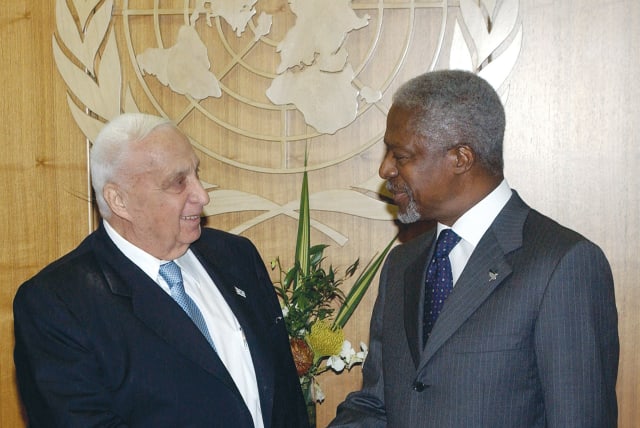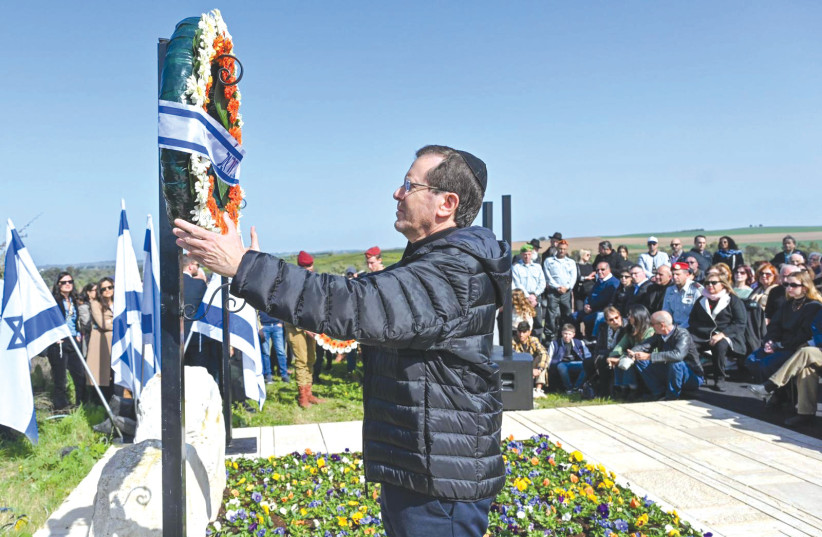Ariel Sharon: The complex legacy of Israel’s warrior-statesman

Sharon’s initial reputation was not entirely undeserved, although few doubted his generalship.
The month of February provides two significant reasons to write about Ariel Sharon. First, “Arik” was born 95 years ago this week. Second, he was elected Israel’s 11th prime minister on February 6, 2001, the hitherto divisive figure receiving an impressive 62.4% of the popular vote (Israelis then directly elected their premier).
At the time, I was serving at Israel’s embassy to the US and distinctly remember the angst with which Washington opinion greeted the news of Sharon’s victory. Israel’s incoming leader was widely viewed as someone whose battlefield prowess meshed with a bellicose approach to politics, conventional wisdom deeming him irresponsibly aggressive.
However, Washington would eventually warm to “Arik.” By the time of his January 2006 stroke and incapacitation, many in DC expressed concern that there was no one capable of filling the void.
Sharon’s initial reputation was not entirely undeserved, although few doubted his generalship. Sharon’s strategy at the Battle of Abu-Ageila in Sinai in the 1967 Six Day War was studied at military academies worldwide, and the photograph of his bandaged head during the crossing of the Suez Canal in 1973 became one of the iconic images of the Yom Kippur War. Yet, for many, Sharon remained the epitome of the shoot-from-the-hip ugly Israeli.
In the 1950s, Sharon was the most effective practitioner of the IDF reprisal raids in which the army responded to terrorist attacks by operating against the locality in enemy territory from where they were launched.
One of many such reprisals was the October 1953 operation against Qibya in the Jordanian-controlled West Bank. There, forces under Sharon’s command were accused of killing some 70 Palestinian villagers, two-thirds of them women and children. (Sharon always argued that any civilian casualties during the raid had been inadvertent).
Sharon’s detractors drew a straight line from Qibya to the September 1982 massacre at the Sabra and Shatila refugee camps in Beirut during the First Lebanon War, when he was defense minister. The exact number of civilian casualties in that atrocity remains elusive, varying from 328 victims (according to a Red Cross report) to ten times that number.
Sabra and Shatila
Sabra and Shatila triggered one of the largest demonstrations in Israeli political history, with protesters calling for the establishment of a state commission to investigate the atrocity. (It was also the first demonstration I took part in since making aliyah.)
The commission was established, and its report called for Sharon’s dismissal from the Defense Ministry. Although no evidence was found implicating Sharon had encouraged the massacre, the commission ruled that he bore indirect responsibility “for ignoring the danger of bloodshed.”
If observers could be critical of his military moves, Sharon’s political record was equally contentious: the calls in the 1970s to oust the pro-Western King Hussein of Jordan and establish an East Bank Palestinian state; the building of dummy Sinai settlements in response to Anwar Sadat’s 1977 peace initiative; launching the much-criticized First Lebanon War; breaking with the West in support for Serbia in the Kosovo War of 1999; the lifelong promotion of the settlement project beyond the Green Line; and the September 2000 Temple Mount visit that provided the pretext for the al-Aqsa Intifada – Sharon’s “bull in a China shop” image was ever pervasive.
And there were those who questioned his integrity. In the 1950s, Israel’s first prime minister David Ben-Gurion, who revered Sharon’s capabilities as a combat commander, remarked: “If only he could overcome his propensity not to tell the truth in his reports, he could be an exemplary military leader.”
When Ezer Weizman resigned as defense minister in 1980, Sharon pressed prime minister Menachem Begin for the appointment. Deputy prime minister Simcha Ehrlich warned Begin: “As defense minister Sharon is capable of surrounding the Knesset with tanks.” Begin, like former prime ministers Ben-Gurion and Levi Eshkol, kept the defense portfolio for himself – until political circumstances changed following the 1981 elections.
When, in the aftermath of Sabra and Shatila, Sharon was forced out of the defense ministry, his confidant, journalist Uri Dan, said: “Those who didn’t want him as IDF chief of staff got him as defense minister; those who didn’t want him as defense minister will get him as prime minister.” Dan’s words were prophetic.
SHARON ASSUMED the premiership at a very difficult moment for Israel. Prime minister Ehud Barak (1999-2001) had accepted a Palestinian state in the West Bank, Gaza, and Jerusalem, but the response was a wave of terrorism that rocked the country. Barak declared that Yasser Arafat was no peace partner but nevertheless continued negotiations. Israelis feared for their safety and were contemptuous of a peace process that just brought more deaths.
Under Sharon’s watch, the violence initially got worse; suicide bombers escalated murderous attacks across the country. But Israelis responded positively to Sharon’s leadership, his special combination of toughness and compassion elevating him to the status of national father figure. And with his successful incremental suppression of Palestinian terror, Sharon’s popularity soared.
In 2003, “Arik” became the first sitting prime minister to be reelected in a decade and a half. And he was more admired than the party he led; when he bolted Likud to establish Kadima in 2005, public support for the former imploded.
That year’s Gaza disengagement cost Sharon many longtime right-wing supporters. But the pullout was popular in Israel and embraced internationally – Sharon’s post-disengagement UN visit in October 2005 saw world leaders lining up to be photographed alongside the celebrated Israeli warrior-statesmen.
We will never know if Sharon’s Gaza withdrawal was designed to sustain Israeli control over the West Bank by putting talks with the Palestinians in formaldehyde, as stated by his chief of staff Dov Weissglas, or whether disengagement was the first step toward a larger West Bank realignment, as advocated by his deputy and successor, Ehud Olmert.
Ultimately, Sharon’s biography includes multiple contradictory stances. For example, he telephoned Begin at the 1978 Camp David summit to lend his support to an Egyptian-Israeli peace deal involving a full Sinai withdrawal and the uprooting of the peninsula’s settlements; but in 1990, he attacked the uncompromising, ever-hawkish Yitzhak Shamir from the Right for supposedly being overly pliant. Both seemingly antithetical acts were nonetheless authentic manifestations of a complex Israeli national hero.
Postscript: In 1997, self-described left-wing filmmaker Avi Mograbi released the hour-long documentary – How I Learned to Overcome My Fear and Love Ariel Sharon – a humorous and insightful depiction of the post-Lebanon/pre-disengagement Sharon. It is free on YouTube and has English subtitles.
The writer, formerly an adviser to the prime minister, is chair of the Abba Eban Institute for Diplomacy at Reichman University. Connect with him on LinkedIn, @Ambassador Mark Regev.
Jerusalem Post Store
`; document.getElementById("linkPremium").innerHTML = cont; var divWithLink = document.getElementById("premium-link"); if (divWithLink !== null && divWithLink !== 'undefined') { divWithLink.style.border = "solid 1px #cb0f3e"; divWithLink.style.textAlign = "center"; divWithLink.style.marginBottom = "15px"; divWithLink.style.marginTop = "15px"; divWithLink.style.width = "100%"; divWithLink.style.backgroundColor = "#122952"; divWithLink.style.color = "#ffffff"; divWithLink.style.lineHeight = "1.5"; } } (function (v, i) { });

